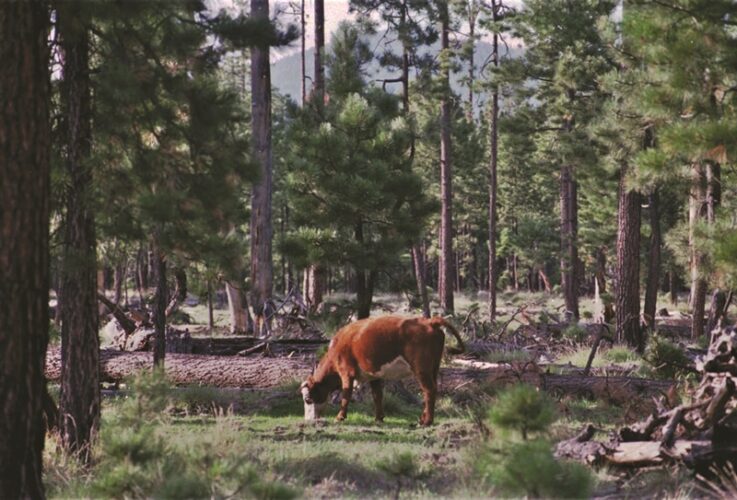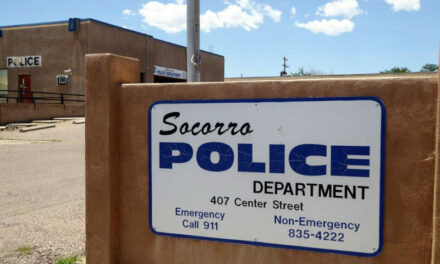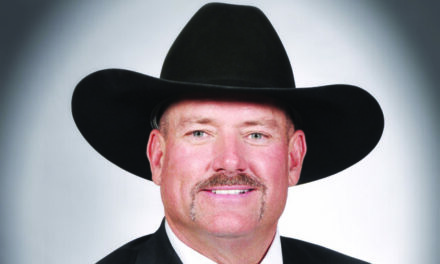The Gila National Forest has completed aerial operations to remove feral cattle within its boundaries using lethal methods.
According to a press release from the Forest Service, a total of 19 feral cows were shot by a specialized USDA Animal and Plant Health Inspection Services Wildlife Services team over three days of operations.
In a press release last week, Gila National Forest Supervisor Camilla Howes emphasized the Forest Service’s commitment to working collaboratively with the ranching community, saying the Gila National Forest “will continue to coordinate with permittees in their efforts to locate, gather, and remove their branded cattle from areas where they are not authorized.”

Gila National Forest officials say unbranded and unauthorized cattle in the Gila Wilderness pose a significant threat to sensitive habits along streams and wetlands.
Richard Pipes | Albuquerque Journal
The feral cattle are not domesticated animals and pose a significant threat to public safety and natural resources, the release said, and the Forest Service will monitor the project area to help develop any future management actions.
“Ground-based and aerial removal efforts since October 2021 have substantially reduced the feral cattle population,” Howes said. “We are committed to removing these feral cattle as safely, efficiently and humanely as possible to ensure a Gila Wilderness that is safe and resilient for generations to come.”
Using aerial methods, searches were conducted with the naked eye and through thermal imagery, allowing crewmembers to see significant numbers of wildlife, including elk, deer, javelina and rabbits. The entire project area was searched at least four times, and no additional cattle were seen.
All cattle dispatched in last month’s operation were left on site to decompose naturally, the press release stated, and no carcasses were shot adjacent to or in any waterbody or spring, designated hiking trail, or known culturally sensitive area.
Loren Patterson of Moriarty, president of the New Mexico Cattle Growers Association, said that the state’s ranchers have been opposed to the program since it was first considered.
“The New Mexico Cattle Growers Association had filed a temporary restraining order trying to keep it from happening,” Patterson said on Friday. “We don’t think the U.S. Forest Service has that authority in there to shoot livestock. And in particular, they have their own document telling them they have to gather any unauthorized cattle.”
He said the NMCGA’s position is that shooting cattle from a helicopter is a waste of money.
“They estimated 150 head in the most recent operation, and they ended up shooting 19,” Patterson said. “That’s a pretty significant cost to the taxpayer.”
The alternative, he said, is the traditional “cowboys on horses.”
“For 40 years, we have been using traditional methods until last year and this year,” Patterson said. “Traditional methods could be utilized again. We think there need to be corrals in that area to make it more humane, but aerial gunning is 100 percent waste.”
According to the Forest Service, due to the “remote, rugged terrain and wild behavior of the cattle,” about half of those removed using ground-based methods historically have not survived capture and removal due to stress or self-inflicted injury and that the use of ground-based methods alone did not sustainably reduce the feral cattle population.”
Patterson disagrees. “Whether you’re talking about the Rio Grande Valley, the Pecos River Valley, there are many places in our state that are just as rough and difficult to gather,” he said. “But we manage to do it. Every year. Year in, year out. We manage to handle the problem.
“What we’d asked for is for temporary holding pens back in there or places to gather those cattle,” Patterson said. “It seems like they have a hard time getting beyond the idea of aerial gunning.”
Patterson contends that part of the issue is maintaining infrastructure.
“There’s nobody maintaining infrastructure anymore, i.e. fences, to keep cattle from getting into places they don’t belong,” Patterson said. “And then, with the Black Fire, there were hundreds of miles of fence that were burned down last year. And there’s no plan on fixing or replacing the fencing. It’s up to the Forest Service to make sure those allotment owners have good fences, or we’ll be going right back in the same boat here in a couple of years.”
Patterson said under normal conditions, allotment owners maintain the fences, “but when you have a catastrophic fire like the Black Fire that demolishes the infrastructure there’s going to have to be a plan to replace them.”
The problem of unauthorized cattle began in the mid-1970s when a permittee declared bankruptcy and abandoned his cattle in the wilderness. Throughout nine contracts for their eradication, a total of 756 cattle have been removed – alive or euthanized – from the Gila Wilderness.



















